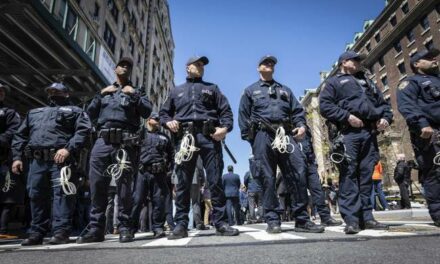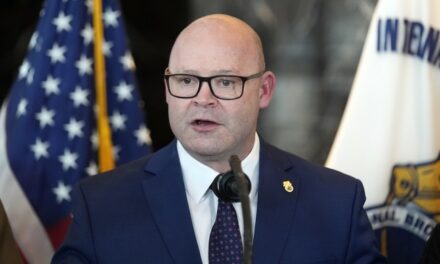We support our Publishers and Content Creators. You can view this story on their website by CLICKING HERE.

No, this melancholy little group of protesters aren’t Hamasholes. They’re, well, former students and supporters of a now-defunct Philadelphia institution of higher learning. A university that had survived 150 years among the pantheon of Philly’s finest schools.
Advertisement
Elmo & @PhillyPolice at the front of a march up Broad Street urging authorities “immediately freeze the assets of University of the Arts & formally investigate UArts sudden abrupt closure.” @FOX29philly following latest developments tonight. pic.twitter.com/jdl9ty6sQM
— Steve Keeley (@KeeleyFox29) June 21, 2024
Impressive, no? Had to be some school.
The forlorn little parade is what turned out to demand an explanation for the Philadelphia University of the Arts’ abrupt closure on June 7.
Extremely sorry to hear about the closing of The University of the Arts in Philadelphia.
My heart goes out especially to the students who are halfway through their degrees and will have to scramble to finish. ☹️ pic.twitter.com/yAe0ejkF2V
— John Wall Barger (@johnwallbarger) June 1, 2024
What had started in 1876 originally as part of the Philadelphia Museum of Art grew into a respected university for the arts in nearly every discipline.
…UArts was one of the oldest art schools in the country. The campus included six academic buildings, four residence halls, nine professional performance venues, and 11 exhibition galleries. It was a private, nonprofit, and nationally accredited institution, and offered 10 degrees, from bachelor’s degrees in fine arts to Ph.D.s.
…The University of the Arts was established through the merger of two foundational Philadelphia arts institutions: the Philadelphia College of Art and the Philadelphia College of Performing Arts, both dating back to the 19th century.
In 1876, Philadelphia established the Pennsylvania Museum and School of Industrial Art in preparation for America’s first official world fair, hosted in the city that year. Over time, the arts museum and school were split to create the Philadelphia Museum of Art and the Philadelphia College of Art.
Advertisement
Place was pretty pricey tuition-wise, too judging by what their website still has up for an undergraduate, all-in-year’s estimate: $79,776
For all its programs, enrollment had been in serious trouble, never regaining pre-pandemic levels.
…[University President] Walk said the university had been struggling for a while, and like many colleges post-pandemic, had lost significant enrollment. This fall the school opened with 1,149 students, down from 2,038 in 2013, she said.
Complicating the matter is that the university is a specially focused arts institution which means there are fewer students talented enough to be admitted, and that’s a harder proposition among a shrinking number of high school students nationwide, she said.
Walk said she first became aware of a significant cash flow problem on May 14 and that it quickly became apparent that the problem was even bigger than originally thought.
“We had unanticipated expenses we had to cover with cash,” she said. “At the same time, some of the deposits [including gifts, grants, and other revenue] we expected into that bank account were late and just didn’t come in.”
The last data the school has shared with municipal bondholders shows that total enrollment fell to 1,313 in the 2022-23 school year from 1,914 in the 2018-19 school year. The drop in freshman enrollment was more dramatic, to 182 from 426 over the same time period.
Yeah, they were bleeding students and money. The “significant cash flow” the president mentions turned out to be a $40M shortfall – I’d say that’s significant.
Advertisement
…Officials said that it remains unclear how dire the university’s financial problems are. According to at least one report, university trustees have said they were facing a financial crisis that required up to $40 million to resolve.
However, as with most of these financially troubled institutions of higher learning, there seems to be an imbalance not just in the books but in the payroll that might contribute enormously to some of the shortfalls. See if you notice what I saw in these numbers.
🚨 LAYOFF ALERT – Philadelphia, Pennsylvania 🇺🇸
University of the Arts, UArts, informed approximately 1,100 students and 700 staffers of imminent closure. About 600 employees were laid off on a conference call on Friday, on what the college said was its final day of operations. pic.twitter.com/F3LCmL4aOD
— The Layoff Tracker 🚨 (@WhatLayoff) June 10, 2024
1100 students to 700 staffers? Now, I’m no forensic accountant – I only play one here at HotAir – but that seems like an awful lot of bodies for too few students, don’t you think? I don’t see how, on those numbers alone, there would be any way of sustaining the school and the university ran on tuition.
Now, President Walk wasn’t responsible for much of that, having only taken the helm at the school less than a year ago.
Her short tenure would also get her off the hook for some of the other missteps at the university that might have led to potential students and their parents being less than taken with the atmosphere on campus.
Advertisement
After all, they’re the university whose uber-queer progressives wanted Professor Camille Paglia booted after 30 years.
I’m a trans-masculine, non-binary Writing for Film and Television junior at the University of the Arts in Philadelphia. UArts is a visual and performing arts based private university–the very university where well-known social critic Camille Paglia teaches humanities and media studies.
Throughout my otherwise rewarding years here, I have dodged the classes she teaches because Paglia refuses to use pronouns preferred by her students and others. This everyone at the school acknowledges and few defend.
As if this was not bad enough, I started doing more research and found over the years she falsely compares her Italian-American background to the culture of people of color, normalizes pedophilia, and has made multiple derogatory statements against trans folk as well as sexual assault victims.
There was even an Atlantic write-up about the dust-up back in 2019.
UArts Students Want Camille Paglia Gone
Such nice kids.
They got their wish. pic.twitter.com/1FI5H0XjU5
— Michael Weingrad (@weingradmichael) June 1, 2024
Artsy, demanding types who now have to go look for a new school and are, instead, doing what they do best.
This morning in Philadelphia, University of the Arts students issued demands to @UArts administrators following the sudden announcement that the school was closing – reportedly due to financial problems, which students say haven’t been properly explained or accounted for. pic.twitter.com/bStOsRHX1P
— UNICORN RIOT (@UR_Ninja) June 4, 2024
Advertisement
In all honesty, a lot of people are asking, “Where’d the money go and how long has it been gone?”
…Something doesn’t add up. Typically, most universities routinely prepare financial plans, budgets, forecasts, monthly financial statements, cash flow analyses and other key management reports that provide up-to-date financial information, including early warning signs of any potential problems. In fact, this level of financial discipline is especially critical at institutions that are fiscally challenged, such as UArts. University leadership should never be in a position of having to say, “like you, we are struggling to make sense of the present moment.”
The fact that no one at the school can explain how and why their financial deficiencies, including an apparent $40 million funding gap, prompted an immediate closure would seem to indicate that these usual and customary financial practices were not being followed at UArts. If this turns out to be the case, it is organizationally and financially irresponsible — a managerial dereliction of duty. And it calls into question the integrity of the university’s senior management team and the quality and effectiveness of the board’s oversight.
And now suggesting obvious economies that are too late and which the university should have been pursuing – downsizing, selling properties, etc.
But it’s all watercolors under the bridge now, and the school is done.
Students are having a problem accepting a truly harsh reality check.
Advertisement
THIS CAN’T BE REAL
Life isn’t fair, princesses – and anyone who told you differently is selling something.
Maybe they could ask for advice from the survivors who climbed out of the wreckage of the college Jane Sanders destroyed in Vermont.
Maybe it’s time they woke up.
Small “w” on that woke.

 Conservative
Conservative  Search
Search Trending
Trending Current News
Current News 







